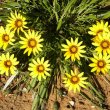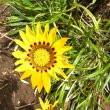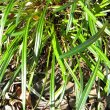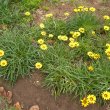| Botanical Name |
|
| Family |
Asteraceae - The daisy family. |
| Pronunciation |
guh-ZAY-nee-uh lin-AIR-iss |
| Common Name(s) |
Afrikaans: Botterblom; Gansblom
IsiXhosa: uBendle; uHlubi
|
| Plant Group |
- Ground Cover A plant with a low-growing, spreading habit, grown specifically to cover the ground.
- Perennial A plant whose life cycle lasts for three or more seasons.
- Veld Flower Small veld flowers of interest, rather than for their usefulness in the garden. Some of these plants have garden potential, particularly for less formal garden situations.
|
| Plant Size |
- Small to Medium
| Tree | 8m to 15m |
| Shrub | 75cm to 1m |
| Perennial/ground cover | 20cm to 40cm |
| Bulb | 30cm to 40cm |
| Succulent | 20cm to 40cm |
|
| Position |
- Sun The area is in full sun for all or most of the day, all year round.
|
| General Information |
- Drought Tolerance: High The plant is well adapted to arid conditions; it can survive long periods of drought and high temperatures without extra water.
- Evergreen Plants that have leaves all year round.
- Frost: Half-hardy The plant is able to survive low temperatures and some frost but requires protection against severe frost.
- Sand tolerant Plants adapted to survive in nutrient poor, very sandy soils.
- Water Wise Plant species originating from low rainfall regions that require less water to survive and thrive than other plant species.
|
| Specific Information |
Gazania linearis is a mat-forming or clumping perennial growing from a single tap root. The long narrow leaves are dark green and shiny above, white and woolly below. The flowers open in the morning sunlight and close at night. Gazania linearis is restricted to the summer rainfall area of South Africa. The buds are reportedly edible and the plant is fire resistant. This plant is often seen in large numbers along roadsides where it carpets the ground with golden flower-heads, especially after good rains. In the wild, the leaves and flower stems are usually much shorter than those grown in cultivation. Many hybrids have been developed from this species.
I have found that in cultivation Gazania linearis becomes rather messy after the second year and flowering is reduced. However it seeds itself easily, so there are always young plants to take over from the older ones.
|
| Ad Break |
|
| Flowers |
| Description |
daisy, up to 8 cm across, often with dark spots at the base
|
| Season |
- Spring to Autumn Plants will seldom bloom for the entire season as given in the list, but should flower during a period within these parameters.
|
| Colour |
|
| Growth Rate |
- Fast Specifying growth rate can be very misleading as there is considerable variation of growth rate depending on type and species of plant, available water, supplementary feeding, mulching and general care, as well as the plants suitability and adaptability to the garden environment.
|
| Plant Uses |
- Attracts bees, butterflies or other insects This plant attracts insects which can be food for birds or other creatures in your garden.
- Bedding Plants, usually annuals, suitable for mass planting in beds for their quick colourful flowers or foliage and used to form a temporary display.
- Border A strip of ground, at the edge of a driveway or path in which ornamental plants or shrubs are planted.
- Container Trees, shrubs and ornamental species that can adapt to growing in a restricted environment.
- Edging A low growing plant that provides softness or definition to the edges of a bed or walkway.
- Filler Either a fast growing tree or shrub used temporarily to fill in an area while the permanent plants grow to a desired size, or a plant used to fill gaps in borders or beds.
- Ground Cover Low-lying plants that spread fast, require minimal maintenance, and cover large expanses or bare areas between bulbs or shrubs. They provide protection from erosion and drought and improve the visual appearance of the garden.
- Mass Planting Plants useful for filling a large area with just one or a few kinds of plants spaced close together. Creates a bold, dramatic effect and to reduces maintenance.
- Pioneer for new gardens A very fast growing plant, able to withstand hardship, that can be used to populate land that has recently been cleared of natural vegetation. These plants pave the way for slower-growing species by adding nutrients to the soil and creating leaf litter.
- Rock Garden An area constructed of larger rocks, arranged naturally, to emphasise the use of stones as a main element. Generally plants used do not need a lot of care.
- Stabilize Banks Plant is used to prevent soil erosion because their roots will form a mat that stabilizes the soil and keeps it from washing away in heavy rains.
- Suitable for seaside gardens Plants that will survive the hostile environment of harsh salty winds, dry sandy soil, irregular rainfall and heat found in seaside gardens.
- Wild Garden An indigenous garden planted for the benefit of wildlife and birds. Provides food, water, a variety of mini-biomes and no poisonous chemicals are used.
|
| Distribution and Habitat |
In the Eastern Cape from Humansdorp, just west of Port Elizabeth to Kwazulu-Natal, in open grassveld and disturbed soil
|
| Planting Suggestions |
This species should be planted in a sunny position in well drained soil. Too much fertiliser or water may result in lush foliage but fewer flowers. Along the roadsides it often dries out completely in winter but returns after the spring rains. In a rock garden it benefits from being sited close to large rocks, where the soil retains some moisture, even during hot, dry periods.
|
| Medicinal Uses |
In early times the white surface of the leaves was peeled off, twisted and threaded with beads then attached as a decoration to the apron-like girdles worn by young girls.
|
| Ad Break |
|








Comments
gazanias
love these wonderful ground cover flowers....blooms go on forever...does anyone know if they are also in the blue color? or what would be a good ground cover that would compliment and behave like the gazanias, only
in blue....
Blue daisies to complement yellow Gazanias
Hi Sel
There are very few blue daisies anywhere - even those you find if you Google 'blue daisy' are actually white daisies that have been dyed blue. The only daisy type flowers that I know of are those of the Felicia family, a low growing sub-shrub that grows to about 30 - 40 cm tall, but can be kept low by judicious pruning.
Felicia amelloides is one of the more common varieties kept by many nurseries, and they also grow very easily from seed. I have included a picture of the plant for you below, and you can go to http://kumbulanursery.co.za/plants/felicia-amelloides for more pics. and information.
Felicia heterophylla is commonly known as 'True blue', as it has a blue centre, but I find it is a bit more of a mauve-blue. Go to: http://www.plantzafrica.com/frames/plantsfram.htm and click 'F' for pictures of this and a number of other Felicia varieties.
I have grown the Felicia aethiopica together with Gazania linearis previously and they make an eye-catching sight.
Kind regards
Lorraine
Discuss this plant
Share knowledge, ask a question or give an experience.